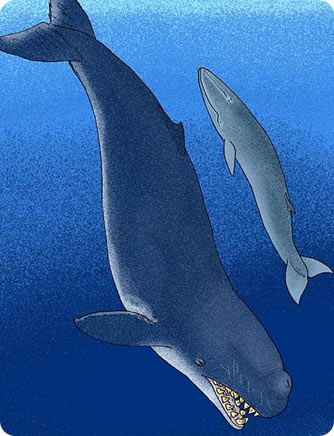You don’t want to get a sperm whale riled up at you. An adult male can weigh up to 50 tons, and it’s one of the oceans’ hungriest predators, gulping down a ton of food per day.
 A Leviathan whale compared to a Cetotherium whale. Credit: Wikipedia/Apokryltaros
A Leviathan whale compared to a Cetotherium whale. Credit: Wikipedia/ApokryltarosIn 1820, the whaling ship Essex was hunting sperm whales when a big male returned the favor. Perhaps thinking the ship was a rival, he rammed it twice, sinking the Essex and condemning her crew to months asea in lifeboats. The tale inspired Herman Melville to write “Moby Dick.”
Yet the modern sperm whale is a pussycat compared to one of its ancient relatives. It had sharp teeth as long as a person’s forearm, and a jaw wide enough to bite a huge hunk out of another whale. The scientists who discovered it named it “Melville’s Leviathan.”
The scientists found a fossilized skull and teeth buried in 13-million-year-old rock layers in the desert of Peru. By comparing the size of the whale’s head to other whales, they concluded that the ancient sperm whale probably was about the same size as its modern-day kin.
But it was far more fearsome. It had several rows of large, sharp teeth. It also had a wider jaw. So the whale could snatch, kill, and rip apart the baleen whales that shared its habitat.
Melville’s Leviathan was found in the same area where scientists have found fossils of a giant shark known as megalodon. So it’s possible that these two mega-predators shared the same waters -- a dream scenario for sci-fi scriptwriters, perhaps, but a nightmare for everything else that swam with these giant killers.

